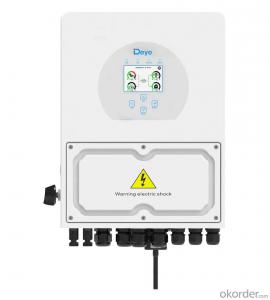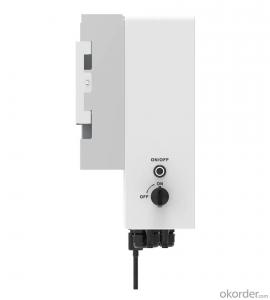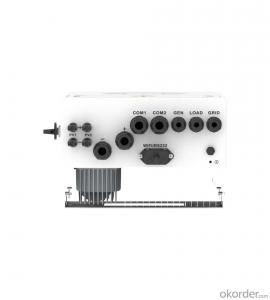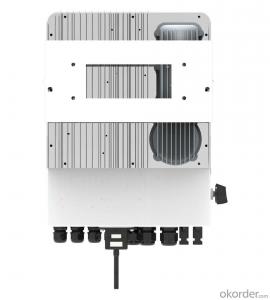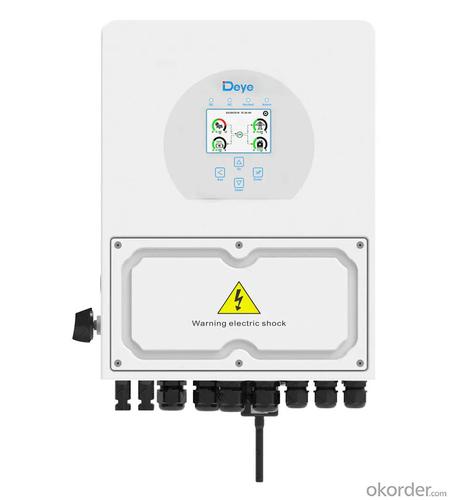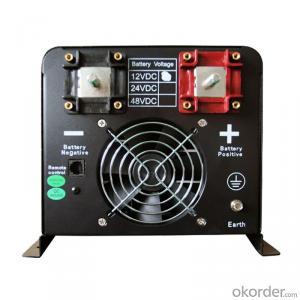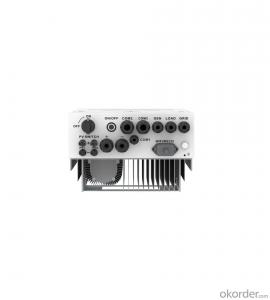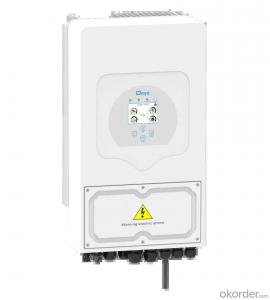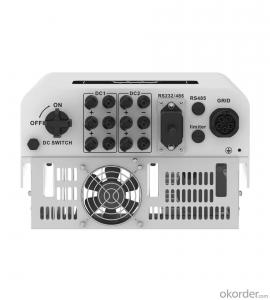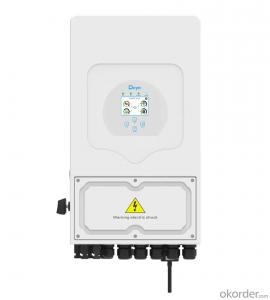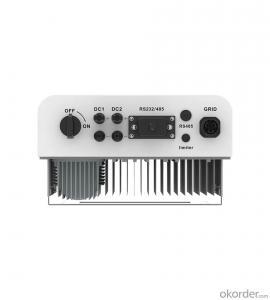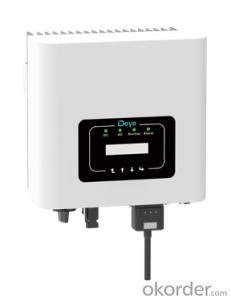15kVA Solar Inverter - Sun-3/3.6/5/6k-SG04LP1 | 3-6kW | Single Phase | 2 MPPT | Hybrid Inverter | Low Voltage Battery
- Loading Port:
- Ningbo
- Payment Terms:
- TT OR LC
- Min Order Qty:
- 100 pc
- Supply Capability:
- 5000 pc/month
OKorder Service Pledge
OKorder Financial Service
You Might Also Like
Specification
| Technical Data | |||||||
| Model | SUN-3K -SG04LP1-24-EU | SUN-3K -SG04LP1-EU | SUN-3.6K -SG04LP1-EU | SUN-5K -SG04LP1-EU | SUN-6K -SG04LP1-EU | ||
| Battery Input Data | |||||||
| Battery Type | Lead-acid or Li-lon | ||||||
| Battery Voltage Range (V) | 20~30 | 40~60 | 40~60 | 40~60 | 40~60 | ||
| Max. Charging Current (A) | 140 | 70 | 90 | 120 | 135 | ||
| Max. Discharging Current (A) | 140 | 70 | 90 | 120 | 135 | ||
| Number of battery input | Yes | ||||||
| Charging Curve | 3 Stages / Equalization | ||||||
| Charging Strategy for Li-Ion Battery | Self-adaption to BMS | ||||||
| PV String Input Data | |||||||
| Max. DC Input Power (W) | 3900 | 3900 | 4680 | 6500 | 7800 | ||
| Rated PV Input Voltage (V) | 370 (125~500) | ||||||
| Start-up Voltage (V) | 125 | ||||||
| MPPT Voltage Range (V) | 150-425 | ||||||
| Full Load DC Voltage Range (V) | 300-425 | ||||||
| PV Input Current (A) | 13 | 13+13 | |||||
| Max. PV ISC (A) | 17 | 17+17 | |||||
| No.of MPP Trackers | 1 | 2 | |||||
| No.of Strings per MPP Tracker | 1 | ||||||
| AC Output Data | |||||||
| Rated AC Output and UPS Power (W) | 3000 | 3600 | 5000 | 6000 | |||
| Max. AC Output Power (W) | 3300 | 3690 | 5500 | 6600 | |||
| AC Output Rated Current (A) | 13.6/13 | 16.4/15.7 | 22.7/21.7 | 27.3/26.1 | |||
| Max. AC Current (A) | 15/14.3 | 18/17.2 | 25/23.9 | 30/28.7 | |||
| Max. Continuous AC Passthrough (A) | 35 | 40 | |||||
| Peak Power (off grid) | 2 time of rated power, 10 S | ||||||
| Power Factor | 0.8 leading to 0.8 lagging | ||||||
| Output Frequency and Voltage | 50/60Hz; L/N/PE 220/230Vac (single phase) | ||||||
| Grid Type | Single Phase | ||||||
| DC injection current (mA) | THD<3% (Linear load<1.5%) | ||||||
| Efficiency | |||||||
| Max. Efficiency | 0.976 | ||||||
| Euro Efficiency | 0.965 | ||||||
| MPPT Efficiency | 0.999 | ||||||
| Protection | |||||||
| Integrated | PV Input Lightning Protection, Anti-islanding Protection, PV String Input Reverse Polarity Protection, Insulation Resistor Detection, Residual Current Monitoring Unit, Output Over Current Protection, Output Shorted Protection, Surge protection | ||||||
| Output Over Voltage Protection | DC Type II/AC Type III | ||||||
| Certifications and Standards | |||||||
| Grid Regulation | CEI 0-21, VDE-AR-N 4105, NRS 097, IEC 62116, IEC 61727, G99, G98, VDE 0126-1-1, RD 1699, C10-11 | ||||||
| Safety EMC / Standard | IEC/EN 61000-6-1/2/3/4, IEC/EN 62109-1, IEC/EN 62109-2 | ||||||
| General Data | |||||||
| Operating Temperature Range (℃) | -40~60℃, >45℃ derating | ||||||
| Cooling | Natural cooling | ||||||
| Noise (dB) | <30 dB | ||||||
| Communication with BMS | RS485; CAN | ||||||
| Size (mm) | 330W x 433H x238D IP65 | ||||||
| Protection Degree | IP65 | ||||||
| Installation Style | Wall-mounted | ||||||
| Warranty | 5 years | ||||||
| Weight (kg) | 14 | 15.1 | |||||
Colorful touch LCD, IP65 protection degree
6 time periods for battery charging/discharging
Max. charging/discharging current of 120A
Max.16pcs parallel
DC couple and AC couple to retrofit existing solar system
Support storing energy from diesel generator
24/48V low voltage battery, safe and reliable
Unique Smart Load application and Grid peak shaving function
4ms fast transfer from on-grid to off-grid mode, ensuing the traditional fixed frequency air conditioner works well
SUN 3/6K-SG04,hybrid inverter, is suitable for residential and light commercial use, maximizing self-consumption rate of solar energy and increasing your energy impendence. During the day, the PV system generates electricity which will be provided to the loads initially. Then, the excess energy will charge the battery via SUN 3/6K-SG04. Finally, the stored energy can be released when the loads require it. The battery can also be charged by the diesel generator to ensure uninterrupted supply in the event of grid blackout.
It equipped with RS485/CAN port for battery communication.
- Q: How does a solar inverter handle voltage regulation in the grid?
- A solar inverter regulates voltage in the grid by converting the DC power generated by the solar panels into AC power that matches the voltage and frequency of the grid. It monitors the grid's voltage level and adjusts the output accordingly to ensure a stable and consistent supply of power. Additionally, it also helps in maintaining power quality by maintaining the grid's voltage within the specified range and compensating for fluctuations or variations in voltage levels.
- Q: How does a solar inverter handle voltage regulation during fault conditions?
- A solar inverter handles voltage regulation during fault conditions by quickly detecting any abnormal voltage fluctuations or faults in the system. It then uses various protective mechanisms such as voltage control algorithms, circuit breakers, and fault detection systems to prevent overvoltage or undervoltage situations. The inverter may also isolate itself from the grid to avoid any potential damage or safety hazards.
- Q: What is the difference between an on-grid and off-grid solar inverter?
- An on-grid solar inverter is designed to convert the DC power generated by solar panels into AC power that can be fed into the electricity grid. It synchronizes the solar power output with the grid's frequency and voltage, ensuring a seamless integration and allowing any excess power to be exported back to the grid. On the other hand, an off-grid solar inverter is used in standalone solar power systems that are not connected to the grid. It converts the DC power from solar panels into AC power for immediate use or storage in batteries. These systems typically require additional components like batteries and charge controllers to manage power storage and supply during periods of low solar generation or high demand. In summary, the main difference between the two types of inverters is their purpose: on-grid inverters are used for grid-tied systems, while off-grid inverters are used in standalone systems not connected to the grid.
- Q: Can a solar inverter be used with any type of solar panel?
- No, a solar inverter cannot be used with any type of solar panel. The compatibility between the solar inverter and solar panel depends on the type and specifications of both the inverter and the panel. It is important to ensure that the inverter is designed to work with the specific type and voltage of the solar panel to ensure optimal performance and efficiency.
- Q: How does a solar inverter handle low light conditions or cloudy days?
- A solar inverter handles low light conditions or cloudy days by adjusting its power output to match the available sunlight. It utilizes Maximum Power Point Tracking (MPPT) technology to optimize energy conversion and extract the maximum energy possible from the solar panels even in low light conditions. This ensures optimal performance and efficiency of the solar system, allowing it to continue generating electricity even during cloudy days.
- Q: How does a solar inverter handle variations in solar panel cleanliness?
- A solar inverter can handle variations in solar panel cleanliness by continuously monitoring the output power and adjusting the operating parameters accordingly. If the panels are dirty, the inverter will detect a decrease in the output power and adjust the voltage and current to maintain optimal performance. However, if the panels are excessively dirty, it can significantly impact the overall energy production and may require manual cleaning to ensure maximum efficiency.
- Q: Can a solar inverter be used in systems with different module tilts?
- Yes, a solar inverter can be used in systems with different module tilts. Solar inverters are designed to convert the DC power generated by solar panels into AC power for use in the electrical grid or in the building. The module tilt refers to the angle at which the solar panels are installed, which can vary depending on factors like geographical location and specific installation requirements. Solar inverters are typically designed to be adaptable and can accommodate a wide range of module tilts, allowing for flexibility and optimization of solar energy generation.
- Q: What are the key considerations for selecting a reliable solar inverter manufacturer?
- When selecting a reliable solar inverter manufacturer, there are several key considerations to keep in mind. First and foremost, it is important to evaluate the manufacturer's reputation and experience in the industry. Look for manufacturers with a proven track record of producing high-quality, reliable inverters. Another crucial factor is the warranty offered by the manufacturer. A reliable manufacturer will provide a comprehensive warranty that covers both the product and its performance over a reasonable period of time. This ensures that any potential issues with the inverter can be addressed and resolved without incurring additional costs. The technical specifications and features of the inverters should also be carefully assessed. Consider factors such as efficiency, reliability, and compatibility with your specific solar panel system. Look for inverters that are capable of effectively converting solar energy into usable electricity while maintaining stable performance in various weather conditions. Furthermore, it is advisable to consider the after-sales support and customer service provided by the manufacturer. A reliable manufacturer will have a responsive and knowledgeable customer support team that can assist with any queries or technical issues that may arise after the installation of the inverter. Lastly, it is beneficial to research and compare reviews and feedback from other customers who have used the manufacturer's inverters. This can provide valuable insights into the overall satisfaction and reliability of the products. By carefully considering these key factors, you can select a reliable solar inverter manufacturer that meets your specific requirements and ensures long-term performance and satisfaction.
- Q: Can a solar inverter be used in systems with different module types?
- Yes, a solar inverter can be used in systems with different module types. Solar inverters are designed to convert the DC power generated by solar panels into usable AC power for homes or businesses. They typically have a wide input voltage range and are compatible with various module types, including monocrystalline, polycrystalline, and thin-film panels. However, it is essential to ensure that the inverter's specifications are compatible with the specific module types being used to optimize efficiency and performance.
- Q: How do you choose the right size of solar inverter for a system?
- When choosing the right size of solar inverter for a system, it is important to consider the total capacity of the solar panels and the expected power output. The inverter should have a capacity that matches or slightly exceeds the maximum power output of the panels to ensure optimal efficiency. Additional factors such as the type of grid connection and any future expansion plans should also be taken into account. Consulting with a professional solar installer or conducting a thorough system assessment can help determine the appropriate size of the inverter for a given solar system.
Send your message to us
15kVA Solar Inverter - Sun-3/3.6/5/6k-SG04LP1 | 3-6kW | Single Phase | 2 MPPT | Hybrid Inverter | Low Voltage Battery
- Loading Port:
- Ningbo
- Payment Terms:
- TT OR LC
- Min Order Qty:
- 100 pc
- Supply Capability:
- 5000 pc/month
OKorder Service Pledge
OKorder Financial Service
Similar products
Hot products
Hot Searches
Related keywords
